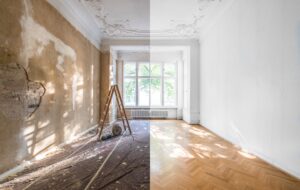Are you a fan of classic architecture and historical homes? Do you often find yourself ogling at the charm and character of old houses in your neighborhood? If so, read on!
From scouting potential properties to finalizing renovations, buying and restoring an old house can be a rewarding experience. Not only do you get to live in a unique and one-of-a-kind home, but you also have the opportunity to preserve a piece of history. However, it’s important to approach this process with caution and careful planning. In this guide, we’ll discuss everything you need to know about buying and restoring old houses.

Why Buy and Restore an Old House?
There are many reasons why people choose to buy and restore old houses. Here are a few of the most common ones:
- Charm and character: Old houses often have unique architectural details that can’t be found in modern homes. From crown molding to stained glass windows, these features add charm and character to a home.
- History and heritage: Old houses have a story to tell. By restoring them, you are not only preserving a piece of history but also contributing to the cultural heritage of your community.
- Affordability: In some cases, old houses can be more affordable than newer homes in the same neighborhood. This is especially true for fixer-uppers that require significant renovations.
- Customization: When buying an old house, you have the opportunity to customize it according to your style and needs. This is often not possible with newer homes that come with strict homeowner association rules.
Scouting Potential Properties
Before you start your search, it’s important to have a clear idea of what you’re looking for in an old house. Consider factors such as location, size, and budget. It’s also a good idea to research the history of the area and any potential zoning restrictions that may affect your plans for restoration.
Once you have a general idea of what you want, it’s time to start scouting potential properties. Don’t limit yourself to online listings – drive around your desired neighborhood and look for “For Sale” signs on old houses. You can also contact local real estate agents who specialize in historical homes. They may know about properties that are not yet listed publicly.
Conducting Inspections
When buying an old house, it’s crucial to conduct thorough inspections before making a purchase. This will help identify any potential issues and give you a better idea of the cost of necessary repairs and renovations. Some important areas to inspect include:
- Foundation: The foundation of an old house is often the most important aspect to examine. Look for any signs of cracks, shifting, or water damage.
- Electrical and Plumbing: As with any home purchase, it’s essential to inspect the electrical and plumbing systems. These are more likely to be outdated in an old house and may need significant updates.
- Roof: A roof can be a costly repair, so it’s crucial to inspect its condition before buying an old house. Look for any signs of leaks or damage.
- Environment: Old houses may have hidden environmental hazards such as lead paint, radon, or asbestos. It’s important to have these substances tested and removed if necessary before starting any renovations. In Longmont, for example, radon mitigation is a common concern for old homes.

Renovation and Restoration
Once you have purchased your dream old house, it’s time to start the renovation and restoration process. It’s crucial to have a well-thought-out plan in place before starting any work. Here are some tips for successful renovation and restoration:
- Preserve original features: When possible, try to preserve and restore any original features of the house. These add character and value to the property.
- Choose quality materials: Don’t skimp on materials when it comes to renovation and restoration. It’s important to use high-quality, durable materials that will last for years to come.
- Work with professionals: Unless you have extensive experience in home renovation, it’s best to work with professionals. They will have the expertise and knowledge to handle any challenges that may arise during the process.
- Stay within budget: It’s easy to get carried away with renovations, especially when restoring an old house. However, it’s important to set a realistic budget and stick to it to avoid financial strain.
Now that you have the basics of buying and restoring old houses, it’s time to start your search for the perfect property. Remember to approach this process with caution and careful planning, and you’ll be well on your way to owning a unique piece of history. Happy house hunting!


